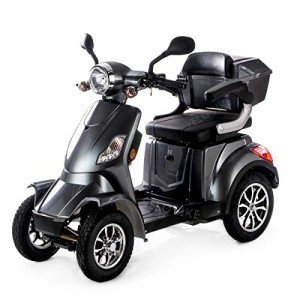A Comprehensive Guide to Buying a Mobility Scooter
Mobility scooters have actually become a vital tool for numerous people wanting to improve their self-reliance and mobility. With a huge array of models and functions offered, choosing the right mobility scooter can be intimidating. This article offers a useful guide to assist consumers navigate their options, assess their requirements, and make an informed purchase.
Understanding Mobility Scooters
Mobility scooters are electric cars designed for individuals who experience mobility challenges. They are particularly helpful for seniors, those with specials needs, or people recuperating from injuries. Mobility scooters can differ commonly in regards to design, functions, and rates.
Types of Mobility Scooters
Before embarking on a purchase, it's vital to understand the different kinds of mobility scooters available:
Three-Wheel Scooters:
- Generally more maneuverable in tight areas
- Lightweight and portable
- Ideal for indoor use
Four-Wheel Scooters:
- Offer higher stability and balance
- Ideal for outside usage over different terrains
- Typically have a longer battery life
Foldable/Portable Scooters:
- Designed to be easily transported and saved
- Can frequently suit the trunk of a vehicle
- Perfect for those who take a trip regularly
Sturdy Scooters:
- Built to accommodate bigger people
- Often featured more robust functions for outside use
- Normally geared up with larger batteries for prolonged range
Factors to Consider When Buying a Mobility Scooter
1. Weight Capacity
Select a mobility scooter that can support the user's weight. A lot of scooters have a weight limitation varying from 250 to 500 pounds. It is vital to ensure that the scooter can accommodate the user comfortably.
2. Range and Battery Life
The range is how far the mobility scooter can travel on a single charge. Common ranges vary between 10 to 30 miles. Consider the user's day-to-day activities and pick a scooter with an appropriate variety.
3. Scooter Dimensions
Think about the size of the scooter, including its weight and measurements. A more compact scooter might be perfect for narrow hallways and tight areas, while larger designs offer extra stability and comfort.
4. Surface Capability
Evaluate where the scooter will mainly be utilized. If the user prepares to travel mainly on pavement, a lightweight model might be sufficient. However, if the user needs to pass through gravel or irregular surfaces, think about a four-wheel scooter constructed for off-road use.
Leading Features to Look For
Comfort
- Adjustable Seats: Look for scooters with cushioned and height-adjustable seats to make sure comfort throughout travel.
- Armrests: These boost security and support while navigating.
Safety and Visibility
- Headlights and Taillights: Essential for nighttime use.
- Turn Signals and Reflectors: Improve exposure and security while on the road.
User-Friendly Controls
- Joystick or Drive Controls: These must be user-friendly and easy to manipulate.
- Easy-to-Read Displays: A control board that reveals battery life, speed, and distance can enhance the user experience.
Extra Features
- Storage Compartments: These offer included benefit for bring individual products while on the go.
- Weather condition Protection: Consider designs with rain covers or windscreens if utilized in variable weather.
Expense Considerations
When budgeting for a mobility scooter, costs can vary anywhere from ₤ 500 to over ₤ 5,000 depending on the model, features, and brand name. Extra costs might consist of:
- Extended Warranty: Protects versus problems and can conserve money in the long run.
- Accessories: Optional functions, such as updated seats, lights, or storage services.
| Function | Cost Range |
|---|---|
| Standard Models | ₤ 500 - ₤ 1,500 |
| Mid-Range Models | ₤ 1,500 - ₤ 3,000 |
| High-End Models | ₤ 3,000 - ₤ 5,000 |
Funding Options
Numerous sellers use financing strategies, and some city government efforts might offer grants or support for those in requirement. Examine possible financial help with neighborhood resources or mobility service companies.
FAQs about Buying a Mobility Scooter
What is the distinction between a mobility scooter and a wheelchair?
Mobility scooters are motorized and allow users to browse independently, while wheelchairs might require physical assistance or manual operation.
How do I preserve a mobility scooter?
Routine maintenance involves inspecting battery life, cleaning the scooter, and inspecting tires and brakes. Constantly describe the user handbook for particular standards.
Can mobility scooters be used inside your home?
Yes, numerous designs are designed for both indoor and outside use. However, best mobility scooters -wheel scooters tend to be better matched for indoor navigation due to their tighter turning radius.
Are mobility scooters covered by insurance?
Some insurance coverage prepares cover a portion of the costs for mobility scooters if they are considered clinically necessary. Contact your service provider for specific details.
How fast can a mobility scooter go?
A lot of mobility scooters have a maximum speed ranging from 4 to 8 miles per hour. Nevertheless, the appropriate speed may differ depending on regional regulations.
Getting a mobility scooter can significantly enhance one's self-reliance and quality of life. By understanding the types, functions, and costs connected with mobility scooters, potential buyers can make educated decisions that suit their needs and choices. Customization and extensive research are crucial to ensuring complete satisfaction with this important investment.

